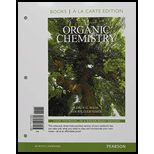
(a)
To determine: The Lewis structure of the given atom, before and after the oxidation of an alcohol to an
Interpretation: The Lewis structure of the given atom, before and after the oxidation of an alcohol to an aldehyde or ketone; and the number of bonds to oxygen that each atom has before and after the oxidation is to be stated.
Concept introduction: Chromic acid is an oxidizing agent in which chromium acts as a multivalent atom. The formation of active species of chromic acid occurs by going through higher oxidation state before the oxidation to a lower oxidation state after the oxidation of alcohol.
(b)
To determine: The Lewis structure of the given atom, before and after the oxidation of an alcohol to an aldehyde or ketone; and the number of bonds to oxygen that each atom has before and after the oxidation.
Interpretation: The Lewis structure of the given atom, before and after the oxidation of an alcohol to an aldehyde or ketone and the number of bonds to oxygen does each atom before and after the oxidation is to be stated.
Concept introduction: Sodium hypochlorite is an oxidizing agent in which chlorine acts as a multivalent atom. The formation of active species of sodium hypochlorite occurs by going through higher oxidation state before the oxidation to a lower oxidation state after the oxidation of alcohol.
(c)
To determine: The Lewis structure of the given atom, before and after the oxidation of an alcohol to an aldehyde or ketone; and the number of bonds to oxygen that each atom has before and after the oxidation.
Interpretation: The Lewis structure of the given atom, before and after the oxidation of an alcohol to an aldehyde or ketone and the number of bonds to oxygen does each atom before and after the oxidation is to be stated.
Concept introduction: Sulphur in the Swern oxidation acts as a multivalent atom. The Swern oxidation comprises use of
(d)
To determine: The Lewis structure of the given atom, before and after the oxidation of an alcohol to an aldehyde or ketone; and the number of bonds to oxygen that each has atom before and after the oxidation.
Interpretation: The Lewis structure of the given atom, before and after the oxidation of an alcohol to an aldehyde or ketone; and the number of bonds to oxygen that each atom has before and after the oxidation is to be stated.
Concept introduction: Iodine in the DMP reagent acts as a multivalent atom. The formation of active species in the DMP reagent occurs by going through higher oxidation state before the oxidation to a lower oxidation state after the oxidation of alcohol.
(e)
To determine: The Lewis structure of the given atom, before and after the oxidation of an alcohol to an aldehyde or ketone, and the number of bonds to oxygen that each atom has before and after the oxidation.
Interpretation: The Lewis structure of the given atom, before and after the oxidation of an alcohol to an aldehyde or ketone and the number of bonds to oxygen that each atom has, before and after the oxidation is to be stated.
Concept introduction: The carbinol
Want to see the full answer?
Check out a sample textbook solution
Chapter 11 Solutions
Organic Chemistry, Books a la Carte Edition (9th Edition)
- Provide the reasonable steps to achieve the following synthesis.arrow_forwardWhen anisole is treated with excess bromine, the reaction gives a product which shows two singlets in 1H NMR. Draw the product.arrow_forward(ii) Draw a reasonable mechanism for the following reaction: CI NaOH heat OH (hint: SNAr Reaction) :arrow_forward
- For the reaction 2 N2O5(g) → 4 NO2(g) + O2(g), the following mechanism has been proposed: N2O5 →> NO₂+ NO3_(K1) NO2 + NO3 → N2O5 (k-1) NO2 + NO3 → → NO2 + O2 + NO (K2) NO + N2O5- NO2 + NO2 + NO2 (K3) d[N₂O5] __2k‚k₂[N2O5] Indicate whether the following rate expression is acceptable: dt k₁₁+ k₂arrow_forwardConsider the following decomposition reaction of N2O5(g): For the reaction 2 N2O5(g) → 4 NO2(g) + O2(g), the following mechanism has been proposed: N2O5 → NO2 + NO3 (K1) NO2 + NO3 → N2O5 (k-1) NO2 + NO3 → NO2 + O2 + NO (K2) NO + N2O5 → NO2 + NO2 + NO2 (K3) Indicate whether the following rate expression is acceptable: d[N2O5] = -k₁[N₂O₂] + K¸₁[NO₂][NO3] - K¸[NO₂]³ dtarrow_forwardIn a reaction of A + B to give C, another compound other than A, B or C may appear in the kinetic equation.arrow_forward
- For the reaction 2 N2O5(g) → 4 NO2(g) + O2(g), the following mechanism has been proposed: N2O5 →> NO₂+ NO3_(K1) NO2 + NO3 → N2O5 (k-1) NO2 + NO3 → → NO2 + O2 + NO (K2) NO + N2O5- NO2 + NO2 + NO2 (K3) d[N₂O5] __2k‚k₂[N2O5] Indicate whether the following rate expression is acceptable: dt k₁₁+ k₂arrow_forwardGiven the reaction R + Q → P, indicate the rate law with respect to R, with respect to P and with respect to P.arrow_forwardSteps and explanations. Also provide, if possible, ways to adress this kind of problems in general.arrow_forward
 ChemistryChemistryISBN:9781305957404Author:Steven S. Zumdahl, Susan A. Zumdahl, Donald J. DeCostePublisher:Cengage Learning
ChemistryChemistryISBN:9781305957404Author:Steven S. Zumdahl, Susan A. Zumdahl, Donald J. DeCostePublisher:Cengage Learning Chemistry: An Atoms First ApproachChemistryISBN:9781305079243Author:Steven S. Zumdahl, Susan A. ZumdahlPublisher:Cengage Learning
Chemistry: An Atoms First ApproachChemistryISBN:9781305079243Author:Steven S. Zumdahl, Susan A. ZumdahlPublisher:Cengage Learning
 Chemistry & Chemical ReactivityChemistryISBN:9781337399074Author:John C. Kotz, Paul M. Treichel, John Townsend, David TreichelPublisher:Cengage Learning
Chemistry & Chemical ReactivityChemistryISBN:9781337399074Author:John C. Kotz, Paul M. Treichel, John Townsend, David TreichelPublisher:Cengage Learning Chemistry & Chemical ReactivityChemistryISBN:9781133949640Author:John C. Kotz, Paul M. Treichel, John Townsend, David TreichelPublisher:Cengage LearningChemistry: Matter and ChangeChemistryISBN:9780078746376Author:Dinah Zike, Laurel Dingrando, Nicholas Hainen, Cheryl WistromPublisher:Glencoe/McGraw-Hill School Pub Co
Chemistry & Chemical ReactivityChemistryISBN:9781133949640Author:John C. Kotz, Paul M. Treichel, John Townsend, David TreichelPublisher:Cengage LearningChemistry: Matter and ChangeChemistryISBN:9780078746376Author:Dinah Zike, Laurel Dingrando, Nicholas Hainen, Cheryl WistromPublisher:Glencoe/McGraw-Hill School Pub Co





